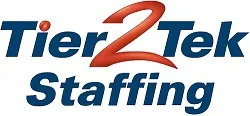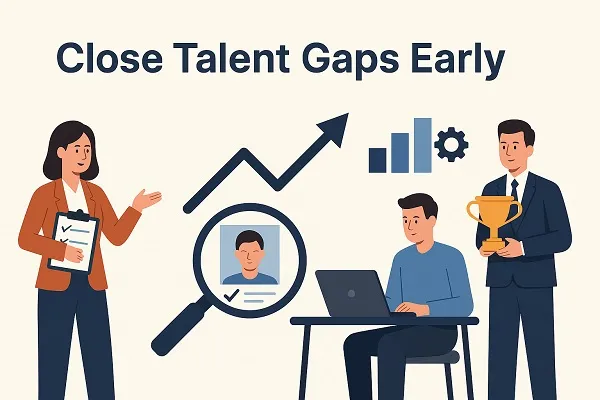Hiring managers who want to maintain strong teams must close talent gaps early. Addressing skill shortages at the start of the recruitment process ensures you secure the right people before gaps grow into long-term business challenges. Acting fast protects productivity, strengthens team performance, and prevents costly turnover.
Why Closing Talent Gaps Early Matters
When talent gaps are left unaddressed, projects slow down, morale dips, and business growth suffers. Hiring managers who focus on early detection and action can:
- Prevent performance bottlenecks by ensuring critical skills are available when needed.
- Boost retention rates because employees see the company investing in their success.
- Reduce recruitment costs by avoiding last-minute, rushed hires.
- Protect customer satisfaction by ensuring deadlines and quality standards are consistently met.
Hiring is not just about filling a vacancy—it’s about strengthening the long-term capabilities of your team.
Spotting Talent Gaps Before They Escalate
One of the most important steps in closing talent gaps early is detecting them before they disrupt workflow. Hiring managers who actively monitor team dynamics can prevent small shortages from becoming costly challenges.
Ways to Identify Early Warning Signs
- Performance slowdowns: Projects are repeatedly delayed due to missing expertise.
- Employee burnout: Team members are stretched thin because they’re covering multiple roles.
- High turnover in specific roles: Indicates that expectations or skills alignment are off.
- Dependence on contractors: If contractors are consistently filling the same role, it signals a gap that should be addressed permanently.
Regularly assessing these indicators allows hiring managers to stay ahead of potential issues.
Identify Skills That Drive Business Impact

To close talent gaps early, hiring managers must first identify which skills directly influence business performance. Instead of creating broad job descriptions, pinpoint what makes a measurable difference.
Strategies to Map Skills Effectively
- Review current team capabilities and compare them against organizational goals.
- Use performance metrics to identify where skills shortages are slowing progress.
- Consult with department leaders to align hiring priorities with company strategy.
- Benchmark against competitors to see where your talent structure may be lagging.
By prioritizing high-impact skills, hiring managers can focus on filling gaps that directly drive results.
Build Proactive Talent Pipelines
Waiting until a vacancy appears is risky. A proactive talent pipeline ensures hiring managers can act quickly. By building relationships with qualified professionals ahead of time, you reduce the risk of delays.
Tactics to Develop a Strong Pipeline
- Networking with industry professionals through events and online platforms.
- Leveraging employee referrals to access trusted, pre-vetted candidates.
- Partnering with recruiters who specialize in your industry.
- Engaging with passive candidates who may not be job-hunting but are open to opportunities.
A pipeline also gives hiring managers the flexibility to compare multiple candidates and select the right cultural and skill fit without rushing.
Leverage Data-Driven Hiring Decisions
Data helps hiring managers spot patterns in skill gaps and make more informed decisions. Instead of relying solely on instinct, use workforce analytics to predict upcoming needs.
Benefits of Data in Closing Talent Gaps
- Forecast skill shortages before they impact productivity.
- Track hiring timelines to identify process bottlenecks.
- Evaluate candidate quality using consistent, measurable benchmarks.
- Measure onboarding success to ensure new hires close the intended gaps.
Data ensures that hiring decisions align with business priorities and prevent gaps from widening over time.
Align Job Descriptions With Actual Needs

Generic job postings often attract the wrong candidates. To close talent gaps early, hiring managers must create accurate, skill-focused job descriptions that clearly state expectations.
Key tips for writing effective job descriptions:
- Focus on essential skills, not a long list of “nice-to-haves.”
- Highlight the impact the role will have on business goals.
- Use language that speaks directly to the ideal candidate’s expertise.
- Be transparent about challenges the candidate will help solve.
Clear job descriptions attract candidates who are genuinely capable of closing existing gaps, saving time and effort in the screening process.
Prioritize Speed Without Sacrificing Quality
Talent gaps worsen when hiring processes drag on. High-quality candidates often receive multiple offers, so hiring managers must strike a balance between speed and diligence.
- Streamline the interview process by cutting unnecessary rounds.
- Use structured interviews to quickly compare candidates fairly.
- Automate repetitive tasks like resume screening with AI tools.
- Set clear hiring timelines to keep decision-makers accountable.
By reducing delays, hiring managers minimize the risk of losing top talent while still ensuring each hire is the right fit.
Strengthen Collaboration Between Teams
Closing talent gaps early isn’t just HR’s responsibility. Hiring managers must collaborate with other leaders to anticipate workforce needs.
Benefits of Collaboration
- Better forecasting of upcoming skill requirements.
- Shared accountability for hiring success across departments.
- Improved onboarding when managers align on role expectations.
- Reduced overlap between departments that compete for the same talent.
Cross-team collaboration ensures that the right people are in place at the right time, avoiding misalignment that can cause gaps to reappear.
Onboarding With Purpose

Hiring alone doesn’t close talent gaps—successful onboarding does. If new hires aren’t integrated quickly and effectively, gaps will remain despite filling the role.
Elements of Effective Onboarding
- Assign mentors or peer buddies to guide new employees.
- Provide role-specific training from day one.
- Set measurable goals for the first 90 days.
- Gather feedback early to adjust expectations or support needs.
Onboarding done right ensures new hires begin adding value quickly and fill the intended gaps immediately.
Retain Talent to Prevent New Gaps
Filling a role is only half the battle—retention prevents new gaps from emerging. Hiring managers should ensure employees feel valued and see opportunities for growth.
Practical Retention Strategies
- Provide mentorship opportunities to support career development.
- Recognize and reward employees for contributions.
- Offer clear pathways for internal mobility to keep top performers engaged.
- Create transparent communication channels to address concerns early.
Retention is one of the most cost-effective ways to keep teams strong and avoid recurring skill shortages.
Closing talent gaps early is one of the most effective strategies hiring managers can use to maintain high-performing teams. By identifying critical skills, building proactive pipelines, using data-driven hiring, streamlining processes, and focusing on retention, you can reduce business risk and keep your workforce agile. The earlier you act, the stronger your team becomes—and the better prepared your organization will be to deliver results.
Content reviewed and published by Tier2Tek Staffing Editorial Team .

